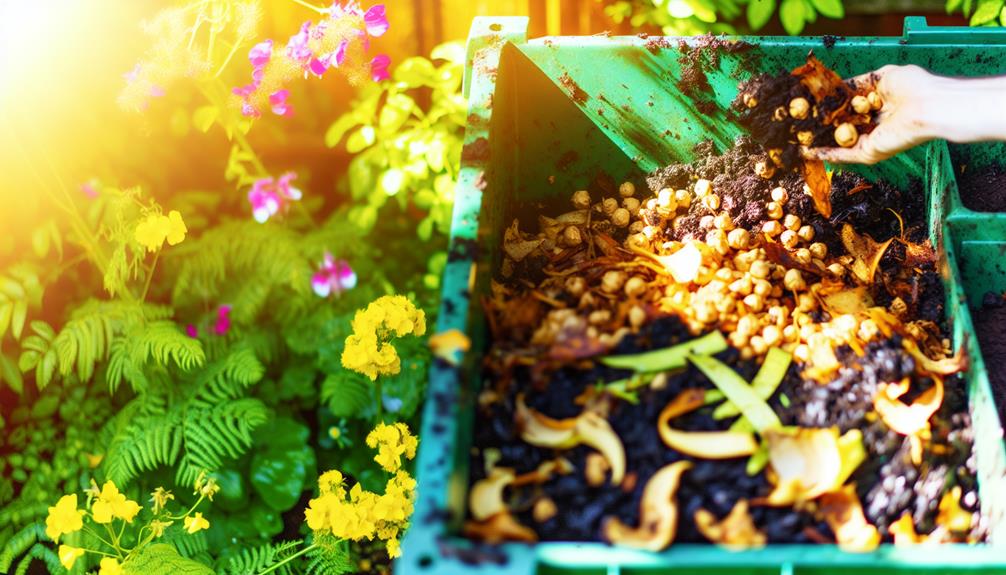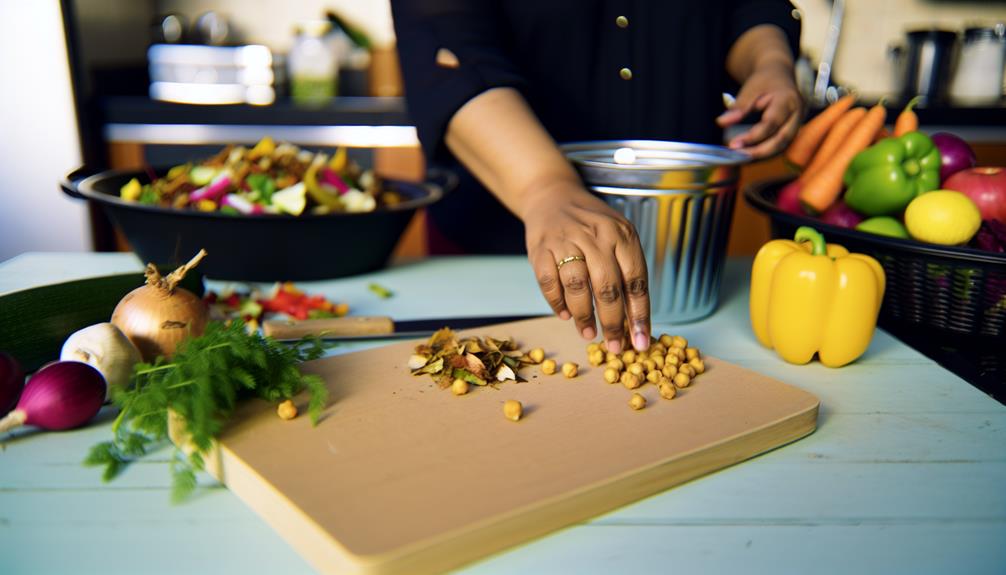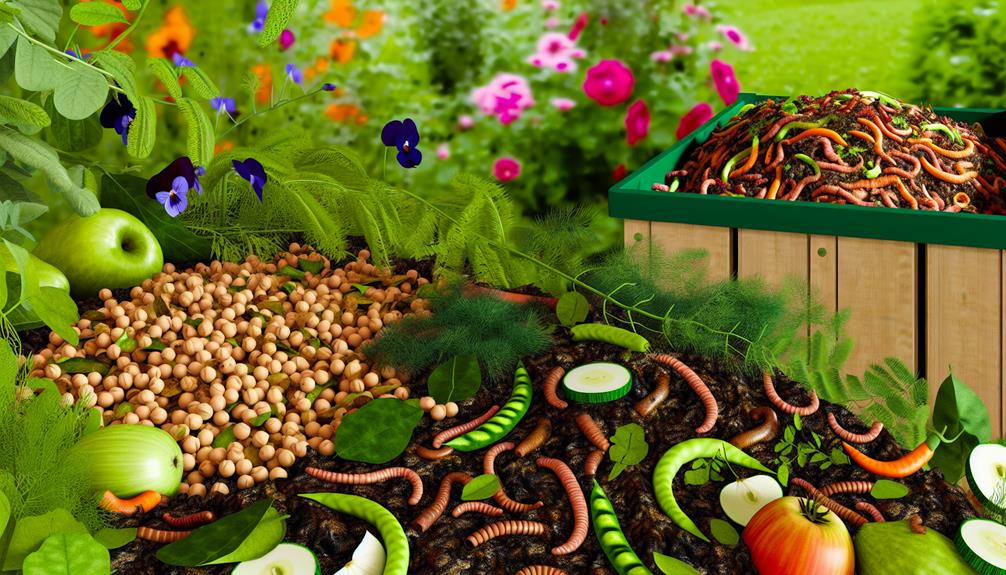

You can compost chickpeas, which will enrich your soil with essential nutrients like nitrogen, phosphorus, and potassium. To get started, rinse and drain the chickpeas, removing any seasonings. Chopping them helps speed up decomposition. Balance your compost pile by mixing chickpeas (greens) with dry materials like leaves or straw (browns).
Keep moisture at the right level—a damp sponge texture works best—and turn the pile regularly for proper aeration. Just be mindful that excessive moisture can cause fermentation issues. With the right technique, your chickpeas will break down in a few months, enhancing your compost’s nutrient profile and garden health. Discover advanced tips next.
Composting chickpeas enriches your soil with essential nutrients and improves its overall health. When you add chickpeas to your compost pile, you’re incorporating a rich source of organic matter that breaks down and releases important minerals. This process not only boosts soil enrichment but also promotes a sustainable gardening practice.
By composting chickpeas, you contribute to soil enrichment by adding nitrogen, phosphorus, and potassium, which are essential for plant growth. These nutrients are slowly released as the chickpeas decompose, providing a steady supply of nourishment for your plants. Additionally, the organic matter enhances soil structure, improving water retention and aeration. This means your plants’ roots can access the oxygen and moisture they need to thrive.
Beyond the direct benefits to your garden, composting chickpeas supports broader sustainability benefits. By recycling kitchen waste, you reduce landfill contributions and lower greenhouse gas emissions. This simple step aligns you with a community of eco-conscious gardeners working towards a healthier planet.
Embracing composting practices not only nurtures your garden but also fosters a sense of belonging in a movement dedicated to sustainability. So, start composting those chickpeas and watch your garden and the environment flourish together.
Chickpeas are filled with essential nutrients like nitrogen, phosphorus, and potassium, making them an excellent addition to your compost pile. These nutrients are crucial for healthy plant growth, ensuring that your garden thrives. When added to compost, chickpeas break down and release their rich mineral profile, which nourishes your soil.
To further understand their nutritional contribution, consider the following table that highlights the primary nutrients chickpeas provide to your compost:
| Nutrient | Benefit to Compost |
|---|---|
| Nitrogen | Promotes leafy growth |
| Phosphorus | Enhances root development |
| Potassium | Boosts overall plant health |
In addition to these essential nutrients, chickpeas have a high protein content, which further enriches your compost. The proteins break down into amino acids and other beneficial compounds, feeding the microorganisms that are crucial for composting. By incorporating chickpeas into your compost, you’re effectively amplifying the nutrient density of your soil.
Their mineral profile includes other essential elements like magnesium and iron, which contribute to soil fertility. So, when you’re looking to boost your compost’s effectiveness, don’t overlook the value of adding chickpeas. They can make a significant difference to your garden’s health and productivity.
Also Read: Can You Compost Celery?
To prepare chickpeas for composting, start by rinsing and draining them thoroughly to remove any lingering liquids. Make sure you remove any seasonings that might alter the compost’s balance.

Chopping the chickpeas into smaller pieces will help speed up their decomposition process.
Before you add chickpeas to your compost, make sure to thoroughly rinse and drain them. This step helps manage water usage and guarantees that any residue is properly disposed of.
Start by placing the chickpeas in a colander under cold running water. Give them a good shake to make sure every chickpea gets a rinse. This removes any surface residue, which could affect the balance of your compost.
Next, let the chickpeas drain completely. Excess water in your compost pile can lead to an imbalance, creating an environment that’s too wet and potentially leading to mold or an unpleasant smell. To avoid this, leave the chickpeas in the colander for a few minutes, allowing them to drain thoroughly. You might even want to pat them dry with a paper towel to be extra sure.
After rinsing and draining, make sure you remove any seasonings or additives from the chickpeas to prevent unwanted chemicals from entering your compost. Seasoning oils and spice residue can harm the composting process and introduce elements that aren’t beneficial for plant growth.
To remove these:
Chopping the chickpeas into smaller pieces accelerates their decomposition in the compost pile. By breaking them down into smaller chunks, you’re increasing the surface area exposed to microorganisms, which leads to a faster breakdown.
So, let’s talk about some effective chopping techniques to get you started.
First, use a sharp knife to guarantee clean cuts. Place a few chickpeas on a cutting board, then chop them into halves or quarters. If you have a large batch, consider using a food processor for efficiency. Just pulse the chickpeas a few times until they’re roughly chopped. Consistency is key here, so aim for uniform pieces to promote even decomposition.
Another tip: If the chickpeas are still firm, you might want to soak them in water for a few hours before chopping. This softens them up, making the chopping process easier and enhancing the faster breakdown in your compost.
When composting chickpeas, consider how the cooking water impacts the composting process. Cooking methods can influence the leftover water, often referred to as aquafaba. This liquid, known for its various culinary uses, can also be a valuable addition to your compost pile.
To make the most of your cooking water:
Using aquafaba wisely can enhance your compost’s nutrient profile without causing imbalance. Remember, the key is moderation and monitoring. By incorporating these tips, you contribute to a thriving compost community, ensuring your pile is healthy and productive.
Together, we can create a sustainable environment through mindful composting practices.
To maintain your compost pile healthy, you’ll need to balance green and brown materials. Greens like chickpeas provide nitrogen, while browns like leaves and cardboard offer carbon.
Guarantee proper moisture and aeration by turning the pile regularly and checking for dampness.
Balancing your compost pile requires a proper mix of green and brown materials to guarantee efficient decomposition. Achieving the right compost ratios is key to maintaining a healthy carbon balance. Greens provide nitrogen, while browns offer carbon. Without the right balance, your compost pile can become inefficient or even smelly.
To help you get the correct mix:
Proper moisture and aeration are essential for a well-balanced compost pile that decomposes efficiently and stays odor-free. When composting chickpeas, you need to pay close attention to moisture retention and airflow management to keep your compost healthy. Too much moisture can make your pile soggy and smelly, while too little can slow down the decomposition process.
To achieve the right balance, aim for a moisture level that feels like a damp sponge—moist but not dripping. Regularly check your pile and add water if it feels dry, or mix in dry materials like straw or shredded paper if it’s too wet.
Aeration is equally important. Turn your compost pile at least once a week to introduce oxygen, which is vital for the microorganisms breaking down the organic material. You can use a pitchfork or a compost aerator tool for this task.
Here’s a quick reference table to help you manage your compost pile:
| Issue | Cause | Solution |
|---|---|---|
| Too Dry | Insufficient water | Add water and mix thoroughly |
| Too Wet | Excessive water | Mix in dry materials |
| Odor | Lack of oxygen | Turn the pile more frequently |
| Slow Decomp. | Poor aeration or dryness | Improve airflow, check moisture |
| Pests | Food scraps on top | Bury food deeper in the pile |
Maintaining the correct moisture levels is crucial when composting chickpeas to guarantee efficient decomposition. Chickpeas, like other legumes, can become problematic if not managed well. Too much moisture can lead to fermentation risks, causing unpleasant odors and slowing down the composting process. On the other hand, insufficient moisture can result in mold growth, which can deter the composting activity.
To secure appropriate moisture levels, here are some tips:
Also Read: Can You Compost Ash?
Even with careful moisture management, you might still encounter some common issues when composting chickpeas. One of the primary concerns is pest attraction. Chickpeas, like other food scraps, can attract unwanted pests such as rodents and insects. To guarantee this, always bury your chickpea scraps deep within the compost pile.
Cover them with a layer of brown materials like dry leaves or shredded paper. This not only helps deter pests but also balances the carbon-to-nitrogen ratio.
Another issue you might face is mold growth. While some mold is a natural part of the composting process, excessive mold can indicate that your pile is too wet or lacks sufficient aeration. To address this, regularly turn your compost pile to improve airflow and ensure even moisture distribution. If the pile becomes too wet, add more brown materials to absorb excess moisture.
Understanding how long chickpeas take to break down in a compost pile can help you better manage your composting process. On average, chickpeas can take several months to fully decompose, depending on various factors. The breakdown rate is influenced by natural enzymes and microbial activity that work together to transform chickpeas into rich compost.
To guarantee chickpeas decompose efficiently, consider the following:
Also Read: Can You Compost Body Wash?
To enhance the decomposition of your chickpeas, you’ll need to maintain proper moisture balance. This involves keeping the compost within an ideal temperature range and guaranteeing regular aeration by turning the pile. Keeping these factors in check accelerates the breakdown process and produces rich compost faster.

Let’s explore each of these elements in detail.
Why is maintaining the right moisture balance essential for composting chickpeas effectively?
Chickpeas, like other organic waste, need the right amount of moisture to break down properly. Moisture retention is key because it helps microorganisms thrive, accelerating decomposition. However, too much or too little moisture can hinder this process.
To achieve the ideal moisture balance, you should aim for a consistency similar to a wrung-out sponge. Here’s how you can manage it effectively:
Maintaining an ideal temperature range is essential for speeding up the decomposition of chickpeas in your compost. You should aim for a range between 135°F and 160°F. This range promotes hot composting, which accelerates the breakdown of organic materials, including chickpeas. When your compost reaches these temperatures, beneficial microorganisms thrive, breaking down the chickpeas more efficiently.
To achieve and maintain this temperature range, monitor your compost regularly. Temperature fluctuations can slow down the decomposition process. If the temperature drops below 135°F, the microbial activity decreases, and decomposition slows. Conversely, if it exceeds 160°F, it can kill beneficial microorganisms, halting the process temporarily.
You can manage the temperature by adjusting the compost’s size, moisture, and balance of green (nitrogen-rich) and brown (carbon-rich) materials. Larger compost piles generally retain heat better, promoting consistent hot composting. Make sure your pile is at least three cubic feet in size. Additionally, insulating your compost with straw or tarp can help prevent temperature fluctuations.
Regularly turning your compost pile is crucial for ensuring adequate aeration, which greatly enhances the decomposition of chickpeas. Proper aeration introduces oxygen into the pile, speeding up the microbial activity that breaks down organic matter. To achieve this, you need to pay attention to the turning frequency and use appropriate aeration tools.
Aim to turn your compost pile every 1 to 2 weeks. This frequency helps maintain ideal oxygen levels and prevents the pile from becoming too compacted. When turning the pile, make sure to bring the materials from the outer edges to the center, allowing them to decompose more evenly.
Here are some tips to help you with turning and aerating your compost:
Also Read: Can You Compost Broad Beans?
Incorporating compost into your garden enriches the soil and boosts plant growth. One way to maximize these benefits is by making compost tea. This liquid gold acts as both a soil amendment and a foliar spray, promoting nutrient uptake and improving plant health.
To create compost tea, steep mature compost in water for a few days, then strain and apply it directly to your plants or soil.
When using compost as a soil amendment, start by spreading a layer of compost over your garden beds. Aim for about 2-3 inches of compost, then mix it into the top 6-8 inches of soil. This method improves soil structure, enhances moisture retention, and provides essential nutrients. It’s particularly effective for vegetable gardens, flower beds, and even lawns.
For a more targeted approach, consider top-dressing. Simply spread a thin layer of compost around the base of your plants. This technique is especially useful for perennials and shrubs, giving them a steady nutrient supply as the compost breaks down.
Yes, cooked chickpeas can attract pests when composted. To prevent this, use pest deterrents and regularly turn your compost. By doing this, you’ll maintain a healthy compost and keep your garden community thriving.
You’re wondering if some chickpea varieties are better for composting. Opt for those with higher nutrient density and faster decomposition rates. This way, you’ll enrich your compost quicker, fostering a thriving community garden for everyone.
Chickpeas can introduce organic acids into your compost, slightly lowering the pH. This helps maintain soil balance, creating a more welcoming environment for diverse plants. Don’t worry; your compost will still be gardener-friendly.
You can compost chickpea sprouts or microgreens! They break down quickly due to their short sprout lifespan and add valuable nutrient content to your compost, making your garden thrive. You’ll feel great contributing to a greener community.
You should rinse chickpeas before adding them to compost. Rinsing benefits your compost by removing excess salt and chemicals, but be mindful of water waste. Striking a balance guarantees you’re both eco-friendly and community-conscious.
In conclusion, you can definitely compost chickpeas. Make sure they’re cooked or soaked to speed up decomposition. Add them in moderation, balancing with carbon-rich materials like leaves or paper.
Avoid adding too much cooking water, as it can make your pile too wet. By maintaining a balanced compost pile and occasionally turning it, you’ll enhance decomposition and produce nutrient-rich compost.
Use this compost to improve your garden’s soil health and plant growth.

Don't let aphids, slugs, and caterpillars ruin another plant. Take back control with simple, natural methods that actually work.